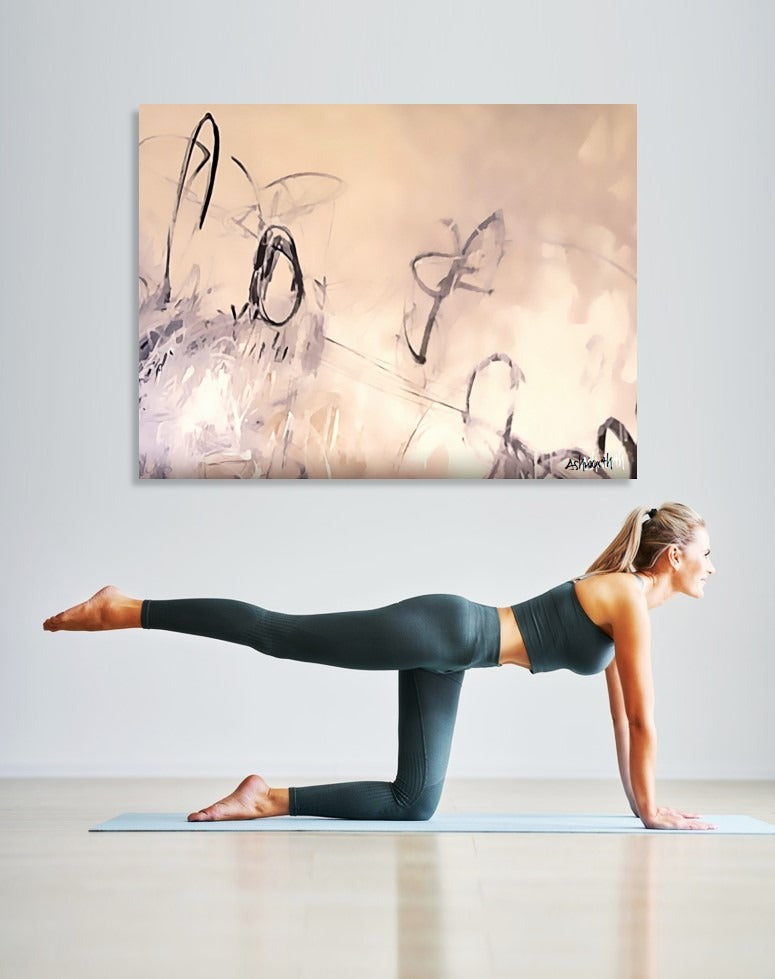
How Your Brain Sees and Interprets Abstract Art
What is abstract art, and how does your brain process and interpret the colors, forms and non-literal messaging.
Here is a foundation for understanding the interplay between abstract art and the brain's perception, delving into both the neuroscience and psychology of the visual experience of non-figurative art.

Abstract art is a unique visual experience that allows both the artist and viewer to explore new dimensions of perception and emotion. From vibrant splashes of color to fluid brushstrokes and dynamic forms, abstract art invites us to look beyond the surface and engage with deeper layers of thought and feeling. Unlike representational art, which depicts recognizable subjects, abstract art offers a more open-ended, interpretive experience. But what exactly happens when we look at abstract art, and how does our brain perceive it? Let’s delve into the science behind abstract art and discover how it impacts our minds and emotions.
The Science Behind Abstract Art
Since the beginning of time, people have been captivated by the unknown. Abstract art plays into this natural curiosity, stimulating the brain and inviting viewers to embark on a journey of exploration and discovery. Research shows that looking at art lights up regions of the brain associated with pleasure and positive emotions. When it comes to abstract art specifically, the brain begins to imagine the ways in which the artist used their tools—be it paintbrushes, palette knives, or digital media—to create their masterpiece.
Unlike paintings that depict concrete objects or symmetrical forms, abstract works don’t fit neatly into predefined categories. Instead, the meaning and beauty of abstract art lie in each stroke, shape, and color, provoking the brain to engage with it differently. It’s a dynamic and ever-changing experience that speaks to the complexities of human perception and emotion.

How Does Abstract Art Affect the Viewer?
Abstract art has the power to alter and enhance the mood and atmosphere of any space. Whether found in homes, offices, or public spaces, abstract works can convey various messages and emotions. For the artist, it’s often a deeply personal expression—a visual language that speaks directly from the mind and heart. For viewers, it’s a chance to interpret and assign meaning to the forms, colors, and emotions on the canvas.
Emotionally, abstract art can resonate with viewers in powerful ways. Collectors and admirers are often drawn to specific works because of the emotional response they evoke. It could be a reaction to the vibrancy of the colors, the energy of the brushstrokes, or the overall composition. According to neuroscientist and Nobel Prize laureate Eric Kandel, abstract art has the unique ability to connect directly with viewers and evoke heightened emotional responses.
The Brain’s Response to Abstract Art
When we look at representational art—such as a landscape or a still life—the brain activates specific regions to analyze and categorize the objects depicted. However, studies have shown that abstract art does not activate any one particular area of the brain. Instead, it stimulates a more holistic and less focal activity. This is because abstract art doesn’t fit into the established categories that our brain has formed based on past experiences and learned visual information.
Viewing art generally engages the frontal cortex and the amygdala, areas of the brain associated with joy and positive emotions. However, when it comes to abstract art, the brain’s activity shifts away from categorization and analysis. Instead, the mind is free to wander, creating unique interpretations and narratives that are personal to each viewer. This open-ended nature of abstract art enables a broader range of emotional and cognitive responses.

How Different People Perceive Abstract Art
The way we process abstract art can vary greatly from person to person. Typically, there are two main approaches to observing abstract art: holistic interpretation and stylistic analysis. The holistic approach is where a viewer interprets the artwork as a complete entity without focusing on the finer details or technique. This is often the case for people who view art casually or who may be unfamiliar with the world of abstract art. The second approach involves processing the artwork based on the artist’s style and techniques. This analytical method is more common among viewers with prior experience or knowledge of abstract art and may require more time to fully appreciate the nuances of the work.
Interestingly, research has also found that viewers tend to concentrate their gaze in specific areas of an abstract painting. A study in 2018 tracked eye movements as participants observed abstract artworks and discovered that most focused on the upper-right quadrant of the image. This could be linked to the right hemisphere of the brain, which is specialized for visuospatial processing and plays a role in the emotions elicited by art. Additionally, certain personality traits influenced viewing patterns, with those who tended toward neuroticism focusing more on the left side and individuals with schizophrenia paying more attention to the bottom of the painting.
While these tendencies provide fascinating insights into how we view abstract art, it’s important to remember that preferences are subjective and shaped by individual experiences, cultural background, and even current mood.

The Role of Psychological Distance in Abstract Art
A fascinating aspect of abstract art is how it shifts our mental focus from concrete details to more abstract ideas—a phenomenon known as "psychological distance." Researchers at Columbia University found that viewing abstract art prompts us to think about the broader concept or feeling behind the work rather than the minute details. For example, when looking at an abstract painting, we might reflect on the emotion it evokes, such as joy or melancholy, rather than the specifics of color or shape.
Psychological distance has the effect of making us see things in a more conceptual way, much like thinking about the idea of a picnic with friends rather than the specifics of what food to bring or where to sit. This cognitive shift can be freeing, allowing us to let go of the minutiae of daily life and focus on larger themes and ideas.

Why Are We Attracted to Abstract Art?
Humans are naturally attracted to the ambiguity and open-endedness of abstract art. The visual interpretation of a stimulus is processed in three stages: viewing the object, associating it with previously stored information, and experiencing the emotional state it provokes. Since abstract art activates areas of the brain that are less familiar, it allows the mind to explore new perceptions and ideas freely. This exploration can be a positive and uplifting experience, as it opens up uncharted areas of thought and emotion.
In essence, abstract art encourages us to look inward and draw on our own thoughts, memories, and emotions to create meaning. It plays a significant cognitive role by stimulating unique areas of the brain and offering a sense of novelty and self-discovery.
How Abstract Art Influences Our Thinking
When we look at realistic art, our brain quickly identifies familiar shapes and objects, allowing us to categorize and make sense of what we see. However, with abstract art, the brain has fewer recognizable signposts. Studies show that when people view abstract art, their eye movements become more global, scanning the entire composition rather than focusing on specific elements. This exploratory strategy is the brain's way of searching for meaning in an open-ended visual space.
The more abstract a painting is, the greater the responsibility on the viewer to assign meaning, utility, and value. This makes the experience of viewing abstract art deeply personal and subjective, often leading to unique interpretations that differ greatly from person to person.

Abstract Art as a Tool for Cognitive and Emotional Exploration
The beauty of abstract art is its ability to transcend visual boundaries and stimulate the imagination. It allows each viewer to see and interpret the work in their own way, resulting in a highly individualized experience. Since no two people perceive abstract art in the same manner, it provides an opportunity for viewers to explore their own thoughts, feelings, and experiences.
For some, abstract art may be challenging, as it requires stepping out of the comfort zone of recognizable forms and straightforward narratives. But for others, it offers a canvas for creativity and self-reflection, allowing the viewer to immerse themselves in the artwork and its limitless interpretations.
Conclusion
Abstract art is not just about what you see on the canvas; it’s about how you perceive, interpret, and connect with it. From altering moods and atmospheres to stimulating deep emotional and cognitive responses, abstract art holds a special place in both the art world and the human mind. Whether you are an art connoisseur or a casual viewer, the experience of engaging with abstract art is a journey into the unknown, one that can be both enriching and transformative.
The next time you find yourself in front of an abstract painting, take a moment to let go of the need for a clear interpretation and allow your mind to wander freely. Embrace the ambiguity, explore the emotions it stirs, and find your own unique narrative within the colors and forms. Abstract art is not just to be seen—it is to be felt and experienced in all its open-ended beauty.

Bibliography
Kandel, E. R. (2012). The Age of Insight: The Quest to Understand the Unconscious in Art, Mind, and Brain. Random House.Nobel Prize-winning neuroscientist Eric Kandel explores how art, science, and the brain intersect, particularly discussing how abstract art connects to emotions and the unconscious mind.
Leder, H., Belke, B., Oeberst, A., & Augustin, D. (2004). "A Model of Aesthetic Appreciation and Aesthetic Judgments." British Journal of Psychology, 95(4), 489-508.This paper proposes a psychological model for how viewers experience and interpret art, offering insights into the appreciation of abstract works.
Zeki, S. (1999). Inner Vision: An Exploration of Art and the Brain. Oxford University Press.Semir Zeki delves into the neuroscience of how the brain processes visual stimuli and explores why abstract art can elicit emotional responses.
Chatterjee, A. (2014). The Aesthetic Brain: How We Evolved to Desire Beauty and Enjoy Art. Oxford University Press.Anjan Chatterjee, a cognitive neuroscientist, discusses how art affects the brain, looking specifically at the neural mechanisms behind aesthetic experiences.
Shohamy, D., & Goldstein, P. (2020). "Abstract Art and Psychological Distance." Proceedings of the National Academy of Sciences.Research showing how abstract art can influence cognitive processes, fostering psychological distance and prompting a shift from concrete details to more conceptual thinking.
Tinio, P. P. L., & Smith, J. K. (Eds.). (2014). The Cambridge Handbook of the Psychology of Aesthetics and the Arts. Cambridge University Press.This handbook explores a variety of perspectives on how people experience art, with sections dedicated to visual arts and the cognitive processing of abstract works.
Kirk, U., Skov, M., Hulme, O., Christensen, M. S., & Zeki, S. (2009). "Modulation of Aesthetic Value by Semantic Context: An fMRI Study." NeuroImage, 44(3), 1125-1132.A study using functional MRI to examine how context influences the perception of abstract art and how different brain areas are activated when interpreting visual stimuli.
Hagerhall, C. M., Purcell, T., & Taylor, R. (2004). "Fractal Dimension of Landscape Silhouette Outlines as a Predictor of Landscape Preference." Journal of Environmental Psychology, 24(2), 247-255.This paper explores the relationship between visual complexity and preference, providing context for why certain abstract compositions, like fractal patterns, can be pleasing to the eye.
Sartwell, C. (2016). Six Names of Beauty. Routledge.Crispin Sartwell's book explores the concept of beauty across cultures and philosophies, examining how abstract forms evoke aesthetic pleasure and introspection.
Mallon, Z. (2011). "The Effect of Viewing Art on the Brain." Psychology Today.An article providing a layperson's perspective on how art impacts brain function and mood, with a focus on the brain's response to abstract art.
Redies, C. (2007). "A Universal Model of Aesthetic Perception Based on the Sensory Coding of Natural Stimuli." Spatial Vision, 21(1-2), 97-117.This paper proposes a model of aesthetic perception based on how the brain processes natural stimuli, with applications to understanding abstract art perception.
Tschacher, W., Greenwood, S., & Kirchberg, V. (2012). "Physiological Correlates of Aesthetic Perception of Artworks in a Museum." Psychology of Aesthetics, Creativity, and the Arts, 6(1), 96-103.A study examining the physiological responses (such as heart rate and skin conductance) of viewers when exposed to different forms of artwork, including abstract art, in a museum setting.
by Peter Ashworth.
Peter Ashworth is a Southern California impact artist whose purpose is to inspire people to feel alive, take them on a journey of transformation, and help them live their best creative life. He believes his art should engage, entertain and uplift his customers to express their creative nature, to spark their imagination, and their desire to live creatively.
He is a working artist available for personally commissioned art.

